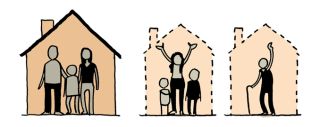Completions Up, Sizes Down

The latest CSO data on new dwelling completions indicates that 7,544 new dwellings were completed in Q3 2022, an increase of 62.5 per cent on Q3 2021 and a decrease of 74 on the previous quarter. The main driver of the increase on the previous year was in apartments, which saw an increase of 153.4 per cent, compared to a 27.1 per cent increase in single dwelling completions, and 44.3 per cent in scheme completions.
Data on urban / rural completions is derived from the ESB connections dataset. Completions in urban areas increased by 73.2 per cent in the year to Q3 2022, while in rural areas, the increase was 25.7 per cent. All eight regions in the country experienced an increase, the highest in Dublin which more than doubled completions from 1,236 in Q3 2021 to 2,630 in Q3 2022, while the region with the lowest growth rate was the South-East (31.2 per cent).
At the same time, the report notes a reduction in average dwelling size. Indexed to 2016, average dwelling sizes fell by 25 per cent by 2022. The size of single dwellings has fallen from 235 sqm in 2016 to 213 sqm in 2022, the average size of a scheme dwelling fell from 135 sqm to 119 sqm in this period, while apartment sizes fell from 77 sqm to 76 sqm in that time, although it should be noted that apartments were the only dwelling types that increased within that period (to an average size of 83 sqm in 2018 and 2019) before falling again.
Where are they?
Dublin saw the highest number of completions overall, with 2,630 in Q3 2022, followed by the Mid-East region (with 1,653). The highest number of single dwellings completed were in the South-West region (278) with Cork accounting for one in eight of all single dwelling completions in the period. Dublin also had the highest proportion of apartment completions at 31.6 per cent.
Who is buying?
In an article earlier this year, we saw how the proportion of new homes purchased by households fell by one third to 61.3 per cent between 2010 and 2021, while the proportion bought by non-household purchasers increased more than five-fold to 38.7 per cent. This pattern continues in the first seven months of 2022, when the split between household and non-household purchasers was 63.5% to 36.5%. Meanwhile the proportion purchased by first time buyers reduced from 51.7 per cent in 2010 to 34.2 per cent in the first seven months of this year.
Non-household (or institutional) purchasers are spread across a range of NACE sectors, including Construction, Financial & Insurance, Real Estate, Extra-Territorial, Public/Education/Health, and Other. In 2011, 61.8 per cent of non-household purchases of new properties were by the Public/Education/Health sectors, while 21.8 per cent were bought by purchasers in the Construction sector. The proportion of purchases by the Public/Education/Health sector fell between 2010 and 2014 (when it was just 16.8 per cent), before increasing steadily from 2015 onwards to reach 58.6 per cent in 2021. In the same period, the proportion of new homes purchased by non-household entities in the Financial & Insurance sector increased from 20 per cent in 2012 to 30.4 per cent in 2013, before fluctuating between 2016 and 2021 (when it accounted for 12.2 per cent). Extra-territorial purchasers accounted for almost one in ten non-household purchases of new properties in 2021, down from 17.4 per cent in the previous year.
Will it solve the housing crisis?
An increase in residential completions is welcome, however depending on who is buying, and at what price, building alone will have little impact on the housing crisis.
Since 2019, the number of residential completions annually has exceeded 20,000, yet the number of people accessing emergency homelessness accommodation has increased. Housing for All, the Government's housing plan, committed to a target of 33,000 completions per annum (a number that underrepresents the actual number of households in need of affordable, sustainable accommodation by some margin). This target was missed last year and is likely to be missed again.
And what is built must be affordable. Between 2010 and 2021, the average purchase price of a new property increased from €220,965 to €364,717. For first time buyers, the increase went from €219,907 to €359,359, while former owner occupiers experienced the highest average purchase prices, ranging from €262,178 in 2010 to €426,976 in 2021.
An increase in completions is only good news if those completions are contributing to a reduction in need, rather than an increase in profit.